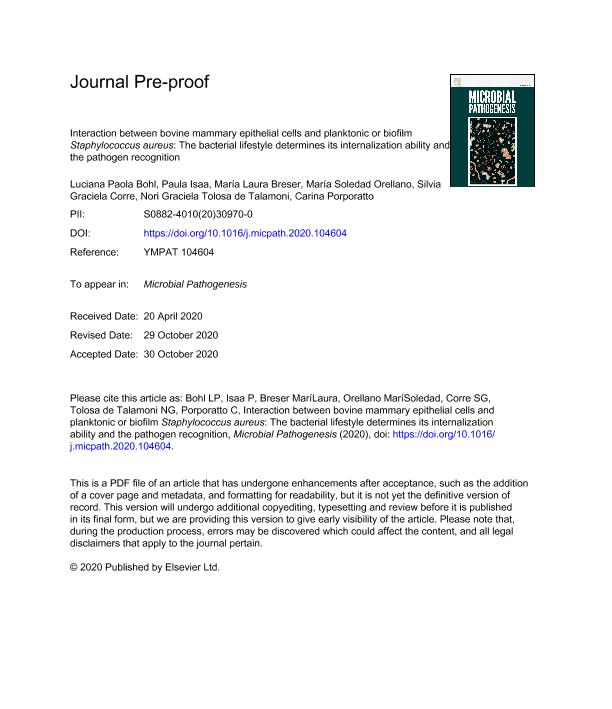Mostrar el registro sencillo del ítem
dc.contributor.author
Bohl, Luciana Paola

dc.contributor.author
Isaac, Paula

dc.contributor.author
Breser, Maria Laura

dc.contributor.author
Orellano, María Soledad

dc.contributor.author
Correa, Silvia Graciela

dc.contributor.author
Tolosa, Nori Graciela

dc.contributor.author
Porporatto, Carina

dc.date.available
2021-09-10T13:50:07Z
dc.date.issued
2021-03
dc.identifier.citation
Bohl, Luciana Paola; Isaac, Paula; Breser, Maria Laura; Orellano, María Soledad; Correa, Silvia Graciela; et al.; Interaction between bovine mammary epithelial cells and planktonic or biofilm Staphylococcus aureus: The bacterial lifestyle determines its internalization ability and the pathogen recognition; Academic Press Ltd - Elsevier Science Ltd; Microbial Pathogenesis; 152; 3-2021; 1-8
dc.identifier.issn
0882-4010
dc.identifier.uri
http://hdl.handle.net/11336/140068
dc.description.abstract
The main cause of mastitis, one of the most costly diseases in the dairy industry, is bacterial intramammary infection. Many of these bacteria are biofilm formers. Biofilms have been associated with resistance to antibiotics and to the host immune system. Here, we evaluated different experimental models representing bacterial biofilm lifestyle with the aim to study bacterial invasion into bovine mammary epithelial cells and the interaction of these cells with planktonic or biofilm Staphylococcus aureus. Staphylococcus aureus V329, its nonbiofilm-forming mutant and bovine mammary alveolar cells (MAC-T) were used. Bacterial invasion was studied using the gentamicin exclusion test, cell viability by trypan blue exclusion technique, TLR2 expression by flow cytometry, IL1β/IL6 production by ELISA and IL8/TNFα gene expression by real-time polymerase chain reaction. Biofilm and planktonic S. aureus showed differences in their invasion ability, with the biofilm mode showing a lower ability. Planktonic S. aureus reduced MAC-T viability after 6 h of co-culture, while biofilms did so at 24 h. MAC-T infected with planktonic bacteria showed increased TLR2 expression. Both lifestyles increased IL8 expression and IL1β/IL6 production but did not modify TNFα expression. Our results demonstrate that the bacterial lifestyle affects the invasion behavior, suggesting that biofilms reduce the bacteria-epithelial cell interaction. Planktonic cultures seem to induce higher cellular activation than biofilms. Further knowledge about the complex host-biofilm interaction is necessary to design more efficient therapies against bovine mastitis.
dc.format
application/pdf
dc.language.iso
eng
dc.publisher
Academic Press Ltd - Elsevier Science Ltd

dc.rights
info:eu-repo/semantics/openAccess
dc.rights.uri
https://creativecommons.org/licenses/by-nc-nd/2.5/ar/
dc.subject
BOVINE MASTITIS
dc.subject
EPITHELIAL CELLS
dc.subject
IN VITRO EXPERIMENTAL MODELS
dc.subject
INNATE IMMUNE RESPONSE
dc.subject
PLANKTONIC AND BIOFILM LIFESTYLES
dc.subject
STAPHYLOCOCCUS AUREUS
dc.subject.classification
Biología Celular, Microbiología

dc.subject.classification
Ciencias Biológicas

dc.subject.classification
CIENCIAS NATURALES Y EXACTAS

dc.title
Interaction between bovine mammary epithelial cells and planktonic or biofilm Staphylococcus aureus: The bacterial lifestyle determines its internalization ability and the pathogen recognition
dc.type
info:eu-repo/semantics/article
dc.type
info:ar-repo/semantics/artículo
dc.type
info:eu-repo/semantics/publishedVersion
dc.date.updated
2021-09-06T15:09:01Z
dc.identifier.eissn
1096-1208
dc.journal.volume
152
dc.journal.pagination
1-8
dc.journal.pais
Estados Unidos

dc.journal.ciudad
Massachusetts
dc.description.fil
Fil: Bohl, Luciana Paola. Consejo Nacional de Investigaciones Científicas y Técnicas. Centro Científico Tecnológico Conicet - Córdoba. Centro de Investigaciones y Transferencia de Villa María. Universidad Nacional de Villa María. Centro de Investigaciones y Transferencia de Villa María; Argentina
dc.description.fil
Fil: Isaac, Paula. Consejo Nacional de Investigaciones Científicas y Técnicas. Centro Científico Tecnológico Conicet - Córdoba. Centro de Investigaciones y Transferencia de Villa María. Universidad Nacional de Villa María. Centro de Investigaciones y Transferencia de Villa María; Argentina. Consejo Nacional de Investigaciones Científicas y Técnicas. Centro Científico Tecnológico Conicet - Córdoba. Instituto de Investigaciones en Ciencias de la Salud. Universidad Nacional de Córdoba. Instituto de Investigaciones en Ciencias de la Salud; Argentina
dc.description.fil
Fil: Breser, Maria Laura. Consejo Nacional de Investigaciones Científicas y Técnicas. Centro Científico Tecnológico Conicet - Córdoba. Centro de Investigaciones y Transferencia de Villa María. Universidad Nacional de Villa María. Centro de Investigaciones y Transferencia de Villa María; Argentina
dc.description.fil
Fil: Orellano, María Soledad. Consejo Nacional de Investigaciones Científicas y Técnicas. Centro Científico Tecnológico Conicet - Córdoba. Centro de Investigaciones y Transferencia de Villa María. Universidad Nacional de Villa María. Centro de Investigaciones y Transferencia de Villa María; Argentina
dc.description.fil
Fil: Correa, Silvia Graciela. Consejo Nacional de Investigaciones Científicas y Técnicas. Centro Científico Tecnológico Córdoba. Centro de Investigaciones en Bioquímica Clínica e Inmunología; Argentina. Consejo Nacional de Investigaciones Científicas y Técnicas. Centro Científico Tecnológico Conicet - Córdoba. Centro de Investigaciones y Transferencia de Villa María. Universidad Nacional de Villa María. Centro de Investigaciones y Transferencia de Villa María; Argentina
dc.description.fil
Fil: Tolosa, Nori Graciela. Consejo Nacional de Investigaciones Científicas y Técnicas. Centro Científico Tecnológico Conicet - Córdoba. Instituto de Investigaciones en Ciencias de la Salud. Universidad Nacional de Córdoba. Instituto de Investigaciones en Ciencias de la Salud; Argentina
dc.description.fil
Fil: Porporatto, Carina. Consejo Nacional de Investigaciones Científicas y Técnicas. Centro Científico Tecnológico Conicet - Córdoba. Centro de Investigaciones y Transferencia de Villa María. Universidad Nacional de Villa María. Centro de Investigaciones y Transferencia de Villa María; Argentina
dc.journal.title
Microbial Pathogenesis

dc.relation.alternativeid
info:eu-repo/semantics/altIdentifier/url/https://www.sciencedirect.com/science/article/abs/pii/S0882401020309700
dc.relation.alternativeid
info:eu-repo/semantics/altIdentifier/doi/https://doi.org/10.1016/j.micpath.2020.104604
Archivos asociados
